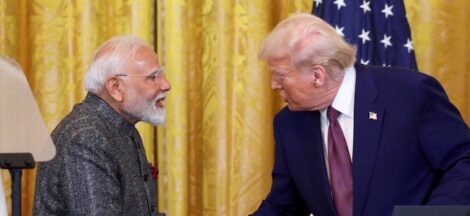By Pablo Castaño
During his first speech in August 2022, Colombian president Gustavo Petro put special emphasis on the environment — a novelty in a country where the security agenda has dominated the political conversation for decades. “There will only be a future if we balance our lives and the world economy with nature,” said the former guerrillero turned president.
A year later, Petro’s commitment to protecting the environment and tackling climate change has remained firm, but he has also run into difficulties. Those setbacks say a lot about the challenges that countries of the Global South encounter when trying to leave extractive industries behind and decarbonize their economies.
The electoral platform of Petro’s left-wing coalition, the Historic Pact, included a prohibition on fracking and a suspension of new explorations of gas and petroleum. The measures would not cancel existing contracts but did imply a first step toward winding down an industry that accounts for nearly half of Colombia’s exports. In response, gas giant ExxonMobil abandoned operations in the country.
“The promise has been respected during his first year in government,” said Tatiana Roa, a renowned ecologist and member of the Colombian NGO Censat. Roa believes that “the government does not want to enlarge the oil frontier.” However, the minister of energy and mines, Andrés Camacho, has watered down Petro’s electoral promise, claiming that “all the [new] contracts that we will sign will be oriented toward the [green] transition.” While citing green energy, Camacho is not completely excluding new exploration contracts.
These vacillations are not surprising, considering that the biggest Colombian petrol company is the partially state-owned Ecopetrol. As stressed by Alejandro Mantilla, political science professor at the National University of Colombia, “halting exploration would lower Ecopetrol’s stock exchange price, damaging state finances.” Despite that threat, Minister Camacho has said that his “intention is to reduce the participation of hydrocarbons,” and Petro clarified the government’s stance at the COP28 conference on climate change in Dubai, where he confirmed that “Colombia has stopped signing contracts for the exploration of coal, oil, and gas.”
Overcoming fossil fuel dependency will also require a deep transformation — and scaling back — of the mining sector. In Colombia, industrial mining is often synonymous with environmental destruction, organized crime, and the murder of social leaders. Illegal mining — together with drugs — is one of the main sources of revenue for the armed groups that still terrorize large parts of the country, despite the disarmament of the FARC guerrilla group in 2016.
According to the United Nations, 98 percent of the murders of social leaders and human rights defenders in Colombia occur in municipalities where drug production or illegal mining takes place. For instance, the Colombian Commission on Truth found international mining firm AngloGold Ashanti responsible for financing paramilitary groups that murdered peasants and community leaders. The same company has been accused of destroying water sources and forcibly displacing thousands of people in the Cauca region. AngloGold Ashanti was one of many multinational corporations given a warm welcome by former president Álvaro Uribe (2002–2010), who is himself accused of links with paramilitarism.
Vice President Francia Márquez is well known for her struggle against illegal mining. Márquez comes from a family of peasants who follow in a tradition of small-scale mining, which is less destructive than the industrial one. However, the government as a whole needs to prove that it has a national proposal to transform the powerful mining sector.
The executive branch tried to forbid open-air mining, but conservative MPs eliminated an article prohibiting the practice from the government’s National Development Plan. Despite this setback, Petro has announced a new mining code that seeks to recognize the rights of small miners who lost their legal protections under previous neoliberal governments.
It remains to be seen if this will be enough to transform the mining sector, which studies have shown is responsible for an increase in poverty and inequality levels in the regions where it is most prevalent. Referring to coal mining, union leader Igor Kareld recognizes that, “at some point, carbon must come to an end, and we need to be prepared for that. We need to look for labour opportunities in an energy transition and productive reconversion.” Renewable energies could be part of the solution, according to Petro’s plans.
Around 70 percent of electricity in Colombia is produced by hydroelectric plants. The second key source is fossil resources, with renewable energy playing only a minor role in the country’s energy grid. However, Colombia has a “very favourable position” for wind and solar energy, says Germán Corredor, former director of the Colombian Association of Renewable Energies: “We have very good solar radiation during the whole year, especially along the Atlantic coast, and very good winds.”
One of the best areas for wind farms is the La Guajira region in the northeast. This impoverished territory near the Venezuelan border is experiencing a “wind rush,” with more than sixty wind farms planned for future construction — although the plan faces opposition from the local population, largely composed of the indigenous Wayuu people.
Representatives of local Wayuu residents say that the companies did not duly inform and consult them before launching the projects, a requirement under Convention 169 of the International Labour Organization and the Colombian constitution. There are further differences of opinion about the role local residents should have in planning such projects, as well as how they should be compensated for the use of their land and the negative impact the wind farms could have on their economy or spiritual activities. The existing wind farm plans would not provide energy to the many Wayuu villages that lack electricity, a blatant injustice that companies do not intend to solve.
Tensions around wind farms in La Guajira are only one example of the challenges Petro faces in the expanding renewable energy in Colombia. The Guajira case shows that, if the interests of local residents are not duly considered, renewable energy projects can be branded with the same “extractivism” label used for predatory fossil fuel extraction.
Petro’s government has boosted the profit sharing that green energy plants must earmark for local residents from 1 to 6 percent, altering the corporate-friendly regulations passed by the previous government. In addition, as Roa explains, the government is trying to increase the government’s role in the electric sector, which is currently controlled by private companies.
Another piece of Colombia’s renewable transition strategy is so-called energy communities — user associations that produce their own green energy. This proposal has been included for the first time in the country’s National Development Plan, and Minister Camacho recently announced the first official call for their creation. He deliberately chose La Guajira to announce the new policy, which targets regions with scattered and impoverished populations.
For some Wayuu villages — and many other indigenous or Afro residents throughout the country — the energy communities proposal could offer an alternative for those areas not connected to the national electric system. It is still too soon to know the real scope of this innovative policy, whose intended beneficiaries are the Colombian people rather than foreign companies, but it does hold promise for a more just energy transition.
“What is more poisonous for humanity: cocaine, coal, or oil?” asked Petro during his first address to the UN General Assembly in September 2022. In a provocative speech that connected the failure of the “war on drugs” with the destruction of the Amazon, the new president launched a proposal addressed to developed countries and international financial institutions: “Reduce our external debt in order to free up our own budgets, and therefore to carry out the task of saving humanity and life on this planet.” Petro was referring specifically to the protection of rainforests, which play a key role in absorbing carbon and protecting biodiversity.
Petro is not alone in this demand: Brazil’s president LuizInácio Lula da Silva has also asked for international cooperation to stop the clearing of the Brazilian Amazon, which, between 2019 and 2023, suffered record rates of destruction and fires under Jair Bolsonaro’s far-right administration. Speaking to a group of European parliamentarians in 2022, Lula asked for the European Union’s help to stop deforestation and promote alternative economic activities, such as pharmaceutical or cosmetic industries. In Colombia, the Historic Pact proposed in its 2022 electoral platform the development of tourism, agroecology, and the use of non-lumber forest products as substitutes for deforestation-related activities, such as cattle breeding.
During the first quarter of 2023, deforestation fell by 76 percent in the Colombian Amazon. Roa considers this improvement to be a consequence, among other things, of the change in the strategy against deforestation since Petro’s arrival to power. Under the previous right-wing government, the main “conservation” policy was military repression of peasants who cleared protected forest areas in the Amazon. As Roa explains, peasants often deforest one area, farm it, and are later dispossessed by large landholders who buy the land or forcibly seize it — pushing peasants to clear other forest areas along an expanding “rainforest frontier.”
Instead, Petro’s government is “reaching agreements with peasants to implement new productive models” that do not swallow up the forest. The policy shift also affects the government’s approach to drugs: Petro’s new anti-drug plan proposes that coca-leaf growers become forest rangers, with the mission of protecting the rainforest.
In August 2023, Petro and Lula met with the leaders of the other six Amazonian countries to relaunch the Amazon Cooperation Treaty Organization. The eight South American governments agreed to look for “innovative funding schemes” to safeguard the rainforest, including foreign debt exchanges, while Colombia and Brazil took a further step, pledging to meet a target of zero deforestation by 2030.
Lula did not follow Petro’s proposal to halt petrol and coal extraction in the Amazon region. Still, Petro’s slogan to swap “debt for life” is slowly making its way throughout the Global South, even if it has not received support from any debtor country or financial institution. (President Joe Biden recently announced a donation of $500 million to the already existing Amazonian Fund, but has not said a word about debt cancellation.)
Roa, however, is skeptical about Petro’s proposal. She is concerned that rather than erasing the country’s foreign debt, it would simply mean exchanging it for environmental protections. “We are trapped in false solutions: financialization of nature and compensation schemes,” says Roa, who considers the proposed scheme to be similar to the existing global carbon market.
The emissions trading scheme allows polluting companies to compensate for their emissions with actions that supposedly offset the same quantity of emissions — for instance, contributing to the protection of a forest area in Colombia that otherwise would be cleared. A recent study concluded that the volume of emissions offset through market mechanisms is much lower than that trumpeted.
In any case, Petro’s proposal has the merit of introducing North-South climate justice collaborations into international debates, demanding rich countries and international financial institutions do their part to shield the rainforests on which humanity’s health depends.
The central place Petro has given to the environment and climate change is a true novelty among the Latin American left. The Pink Tide, which led the region in the early twenty-first century, was propelled by the rise of commodity prices and the windfall that resource extraction left for progressive social policies. Justifiably focused on economic development and poverty reduction, decarbonization was never a top priority for Hugo Chávez, Evo Morales, Rafael Correa, Néstor and Cristina Kirchner, or the first Lula governments in Brazil.
Petro’s firm commitment to a green transition in Colombia is praiseworthy in a country whose annual oil exports are worth around $10 billion but account for less than 1 percent of global CO2 emissions. True, the relatively low contribution of Colombia to climate change makes it more difficult to convince the electorate of the urgency of decarbonizing the national economy. But this has not prevented the left-wing president from taking substantial action to reduce dependency on hydrocarbons, transform the mining sector, promote green energy, or protect the Amazon. Green politics in the Andean country are married to an ambitious social agenda that intends to reduce inequality and poverty rates. Petro has made clear his intention to become a global model with powerful gestures such as endorsing the Fossil Fuel Non-Proliferation Treaty, promoted by a group of states whose existence is threatened by rising sea levels.
Nevertheless, the “path dependency” is huge in a country that for decades has lived off the extraction and export of its valuable natural resources. By initiating the country’s green transition, Petro is confronting the interests of powerful economic elites, well-represented in parliament by several traditional parties. It would be naive to expect Colombia to be a much greener country in 2026, when the president’s mandate ends.
But if the government succeeds in slightly changing course to move toward a more environmentally sustainable economy, it will be an extremely valuable example for governments and social movements around the globe. If a developing country like Colombia can do it, what will be the excuse for countries in the Global North? (IPA Service)
Courtesy: Jacobin



